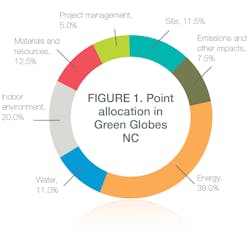What Owners Need to Know About ... Green-Building Rating Systems
In a recent survey of 312 executives with organizations that own or rent space or design or construct buildings,1 62 percent said their organizations would be “extremely” or “very likely” to seek LEED (Leadership in Energy & Environmental Design) certification if they were constructing or renovating a building, up from 48 percent two years earlier. Interestingly, however, the number of respondents reporting they would be “very likely” to seek an alternative to LEED certification increased nearly 153 percent—from 17 percent to 43 percent—over the same two-year period.
With so many choices, it is important for facility owners to have at least a nodding familiarity with the various building rating systems. This article takes a look at LEED, Green Globes, ENERGY STAR, and the Living Building Challenge, the most widely recognized building rating systems in the United States.
LEED
Developed, promulgated, and maintained by the U.S. Green Building Council (USGBC), LEED is the best-known rating system and boasts the largest number of certified properties. Relying on an independent third-party verification process, it serves to drive green-building design, construction, and operation, considering site characteristics, energy and water consumption, the use of resources/materials, and indoor environmental quality (IEQ). It offers separate tracks for new construction and existing buildings, as well as a rating system specific to health-care facilities. Lastly, it is accepted by the U.S. General Services Administration (GSA) and other agencies of the federal government, as well as many, if not most, state and local jurisdictions.
Within LEED, there are five distinct rating systems: Building Design and Construction (BD+C), Interior Design and Construction, Building Operations and Maintenance (O+M), Neighborhood Development, and Homes. Building operators typically are concerned primarily with O+M, which is for existing buildings; however, BD+C applies to buildings going through a major renovation.
LEED has undergone significant changes since its introduction in 2000. The newest version, LEED v4, emphasizes product transparency, life-cycle analysis, and increased thresholds related to energy, water, waste, and IEQ. Although a few buildings have been certified under LEED v4, the date to which users can register projects under LEED 2009 recently was extended from June 15, 2015, to Oct. 31, 2016.
Green Globes
Like LEED, Green Globes serves to drive green-building design, construction, and operation; relies on an independent third-party verification process, although its approach is much different (more on that later); considers site characteristics, energy and water consumption, the use of resources/materials, and IEQ; offers separate tracks for new construction and existing buildings, as well as a rating system specific to health-care facilities; and is accepted by the GSA and other agencies of the federal government, as well as many, if not most, state and local jurisdictions.
Adapted from the Canadian version of the BREEAM environmental assessment method and rating system for buildings, Green Globes was launched in the United States by the non-profit Green Building Initiative (GBI) in 2005. It offers three environmental assessment and certification programs for commercial buildings: New Construction (NC), Existing Buildings (EB), and Sustainable Interiors. Updated in 2013, NC is based on ANSI/GBI 01-2010, Green Building Assessment Protocol for Commercial Buildings, and, like LEED v4, includes life-cycle analysis. A major revision of EB is scheduled for 2015.
For government buildings, GBI offers Guiding Principles Compliance.
Green Globes and LEED focus on the same general environmental areas with similar weighting as to importance, as shown in figures 1 and 2.
Green Globes vs. LEED
The certification process for Green Globes is quite different than that for LEED. Both systems rely on online tools; however, Green Globes’ are interactive and provide immediate feedback, while with LEED, data are uploaded without any feedback, except notification of protocol errors. Although both Green Globes and LEED require a minimum number of points for certification, LEED has prerequisites that have no point value, while Green Globes does not. Someone very knowledgeable in the industry humorously likened the LEED prerequisites to a person’s appendix: “We’re not sure what it does, but it can kill you!” Green Globes allows non-applicable categories to be excluded from the total point count, thus ensuring buildings are not penalized for categories with no applicability to them and eliminating potentially expensive “point chasing.”
From my perspective as a consultant, the most significant difference between the two systems is the time and cost required to complete the certification process. According to the GBI, Green Globes certification typically is completed in three to five months at one-third to one-half the cost for a comparable LEED certification. My experience shows the total cost of Green Globes EB certification typically is about 40 percent of the cost of comparable LEED 2009 certification and is accomplished in as little as one-third of the time required for LEED. The cost difference between Green Globes NC and LEED also is significant. According to Turner Construction Co.’s Green Building Market Barometer 2012, two of the primary reasons industry executives do not seek LEED certification for their buildings are the cost and time required.
My personal experience also shows the review process for Green Globes to be significantly more user-friendly than that for LEED. With Green Globes, an independent assessor is personally involved by phone and/or e-mail throughout the process and, at the end of construction (NC) or completion of an online survey (EB), visits the site and meets with the owner and consultant to review the project. The GBI’s third-party assessors generally are licensed architects or engineers with extensive industry experience, while the reviewers hired by the Green Building Certification Institute (the USGBC’s “independent” certifying body) are anonymous and may not have the same level of experience. Because there is a longer time lag between data submission and user feedback, LEED projects can experience long delays and involve costly appeals. In the case of Green Globes, many issues can be resolved immediately through face-to-face discussion.
ENERGY STAR
ENERGY STAR for buildings is quite different from LEED and Green Globes. It is intended to help owners save money and reduce greenhouse-gas emissions by making their buildings more energy-efficient.
Relying on the U.S. Energy Information Administration’s Commercial Buildings Energy Consumption Survey database, ENERGY STAR provides an online benchmarking tool, Portfolio Manager, that allows more than 25 different types of facilities to be compared to peer buildings nationwide and receive a score based on their relative energy-efficiency performance. If, after adjustments for climate/weather are made, a building is shown to be more efficient than 75 percent of comparable buildings, it receives ENERGY STAR certification. Energy, the largest component category in both LEED and Green Globes (figures 1 and 2), is the only scored category in ENERGY STAR (water consumption is tracked, but does not count toward certification). Still, LEED and Green Globes recognize ENERGY STAR as a complementary system and award energy credits/points based on the ENERGY STAR score of certain types of existing buildings.
Living Building Challenge
The Living Building Challenge is arguably the built environment’s most rigorous performance standard. It recognizes four typologies: Renovation, Infrastructure + Landscape, Building, and Community. If a project attains all imperatives assigned to its typology, Living Building Certification is awarded. For projects unable to achieve full certification, Petal Certification or Net Zero Energy Building Certification can be achieved. Petal Certification requires satisfaction of imperatives related to limits to growth and inspiration and education, as well as at least one imperative in the areas of water, energy, and materials. Net Zero Energy Building Certification recognizes buildings that meet the energy imperatives, along with imperatives related to place, equity, and beauty. As a sustainability visionary told me, “LEED and Green Globes is doing less bad; the Living Building Challenge is doing good.”
Conclusion
At the end of the day, owners need to decide which of the green-building rating systems best meets their individual needs, based on many factors, including cost. At the end of the day, however, any certification will help them do both good and do well.
Reference
1) Turner. (2014). 2014 green building market barometer. New York: Turner Construction Co. Available at http://www.turnerconstruction.com/about-us/sustainability/green-market-barometer
A member of HPAC Engineering’s Editorial Advisory Board, Lawrence (Larry) Clark, CEA, GGP, LEED AP O+M, is principal of Sustainable Performance Solutions LLC, provider of energy audits, general energy-efficiency and sustainability consulting services, and metering and submetering solutions. He has more than a dozen published articles on HVAC- and energy-related topics to his credit and frequently lectures on central-energy-plant optimization, metering/submetering, and advanced ventilation. He blogs semimonthly for HPAC Engineering’s weekly Fastrack electronic newsletter. To subscribe, click here.
About the Author
Larry Clark
A member of HPAC Engineering’s Editorial Advisory Board, Lawrence (Larry) Clark, QCxP, GGP, LEED AP+, is principal of Sustainable Performance Solutions LLC, a South Florida-based engineering firm focused on energy and sustainability consulting. He has more than two dozen published articles on HVAC- and energy-related topics to his credit and frequently lectures on green-building best practices, central-energy-plant optimization, and demand-controlled ventilation.


